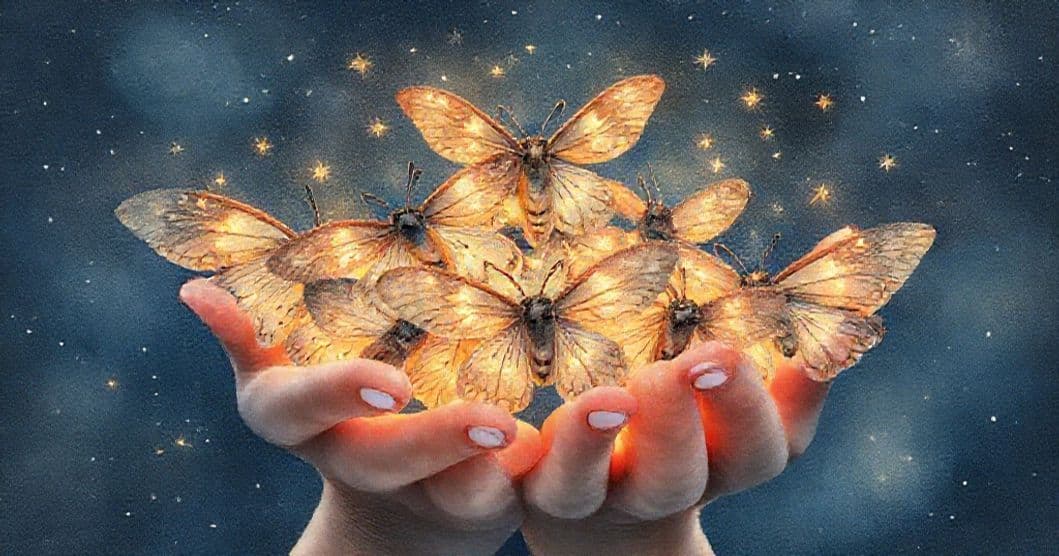Core Symbols: Moths, Embers, and Celestial Patterns
Moths in dreams carry layered symbolism beyond their ephemeral appearance. Unlike butterflies’ association with immediate transformation, moths often represent the slower, more deliberate unfolding of change—a process of becoming rather than arriving. When they cluster like constellations, they shift from individual symbols to a collective, suggesting interconnectedness in your life’s journey. The 'humming' adds another dimension: sound in dreams rarely appears randomly; it may signify the quiet, persistent energy of your subconscious, the hum of unspoken thoughts or unresolved feelings that demand attention.
Embers, the glowing remnants of fire, bridge the gap between active passion and dormant potential. In dreams, they’re not just dying flames but living embers—warmth that refuses to fully extinguish, a reminder that even what feels spent still holds energy. Cradling these embers isn’t just holding something fragile; it’s an act of conscious care, suggesting you’re nurturing a spark of hope or purpose that might otherwise fade. Together, moths and embers create a paradox: the delicate (moths) holding the persistent (embers), symbolizing how vulnerability and resilience can coexist in your emotional landscape.
Psychology Lens: From Jungian Archetypes to REM Processing
Want a More Personalized Interpretation?
Get your own AI-powered dream analysis tailored specifically to your dream
🔮Try Dream Analysis FreeJungian psychology offers a rich framework here, where moths might align with the Anima/Animus archetype—the inner feminine/masculine aspects of self that bridge conscious and unconscious. The constellation pattern could represent the Self’s attempt to organize fragmented experiences into a meaningful whole, much like how we map constellations in the night sky. The 'humming' might echo the collective unconscious’s murmurings, the archetypal sounds of humanity’s shared experiences of transformation and connection.
Freud, meanwhile, might view the dream through the lens of repressed desires. If moths are drawn to light (like embers), this could symbolize repressed longings for warmth, purpose, or recognition. The cradling action might represent the ego’s attempt to contain these desires rather than letting them burn out completely. From a neuroscience perspective, REM sleep—when most vivid dreaming occurs—activates the amygdala, processing emotions while the prefrontal cortex weaves them into narratives. This explains why dreams often feel both emotionally charged and symbolically abstract, as the brain synthesizes fragmented feelings into stories.
Life Triggers: When Dreams of Moths and Embers Arise
This dream tends to surface during periods of transition, when your subconscious is processing uncertainty. If you’ve recently left a stable job for freelance work, the moths—tiny, fluttering, yet numerous—might mirror the scattered energy of starting anew. The embers could represent the warmth of your passion for the new path, while the constellations remind you to see this chaos as part of a larger pattern. Another trigger: relationships in flux. If you’re nurturing a new connection or rekindling an old one, moths might symbolize the delicate balance of care and vulnerability.
Consider Maria, who dreamed of cradling moths embers while constellations hummed. She’d recently left a stable job for freelance work, feeling both the warmth of possibility and the anxiety of uncertainty. The moths, tiny yet numerous, represented her scattered energy, while the constellations mirrored the new patterns she was trying to discern. The 'humming' felt like a gentle affirmation, urging her to trust the process even when clarity felt distant.
What To Do Next: Nurturing the Dream’s Message
Start with short-term reflection: Set aside 10 minutes daily to journal about the emotions tied to your dream. Ask yourself: What felt warm vs. fleeting in the dream? Did the moths feel like allies or obstacles? This reflection helps you identify which parts of your life need gentle nurturing versus letting go.
For medium-term experimentation: Create a 'cradling ritual'—a small, daily act of care that mirrors the dream’s nurturing energy. It could be tending a houseplant, writing a gratitude note, or simply sitting quietly with a cup of tea. Notice how this ritual affects your emotional state, as it trains your conscious mind to hold space for what matters.
For long-term integration: Map your 'constellation of priorities'—a visual or written list of what truly lights you up. Place this somewhere visible to remind yourself that even when things feel scattered (like moths in the dark), there’s an underlying pattern guiding you. The key is to honor both the delicate (moths) and the persistent (embers) aspects of your journey, trusting that your subconscious knows the way forward.
FAQ: Answering Common Questions About This Dream
Q: What does it mean if the moths in my dream feel overwhelming or destructive?
A: Overwhelming moths may signal fear of change or feeling consumed by responsibilities. The 'humming' could feel like internal pressure, suggesting you need to distinguish between what you’re nurturing and what’s draining you.
Q: Is there a cultural meaning to moths in dreams across different traditions?
A: In some Native American cultures, moths are seen as messengers from ancestors, bridging the living and spirit worlds. In Japanese folklore, they symbolize transience and the beauty of impermanence, aligning with the dream’s themes of holding onto what’s fleeting yet meaningful.
Q: How can I tell if this dream relates to a specific area of my life, like career or relationships?
A: Notice the 'humming' context—if comforting, relationships; if urgent, career or health. The embers’ warmth might feel like a 'yes' to a new path, while the cradling could indicate needing to protect that spark. Reflect on recent decisions or unmet needs.
